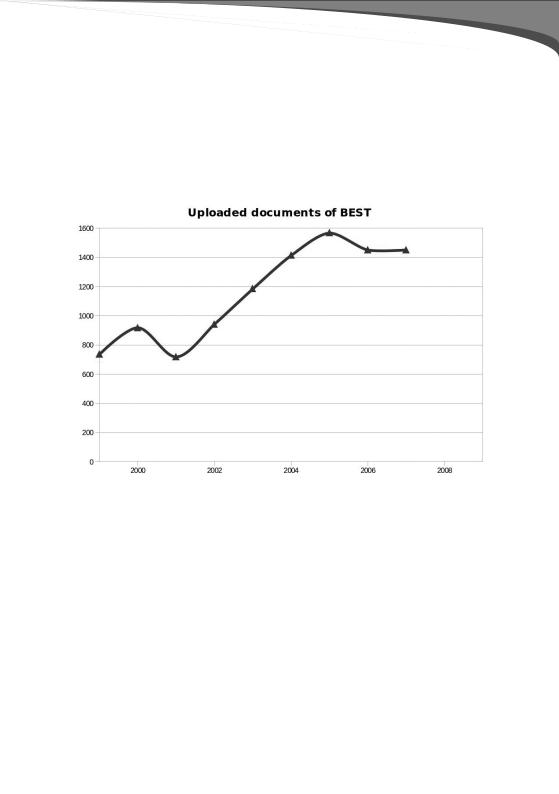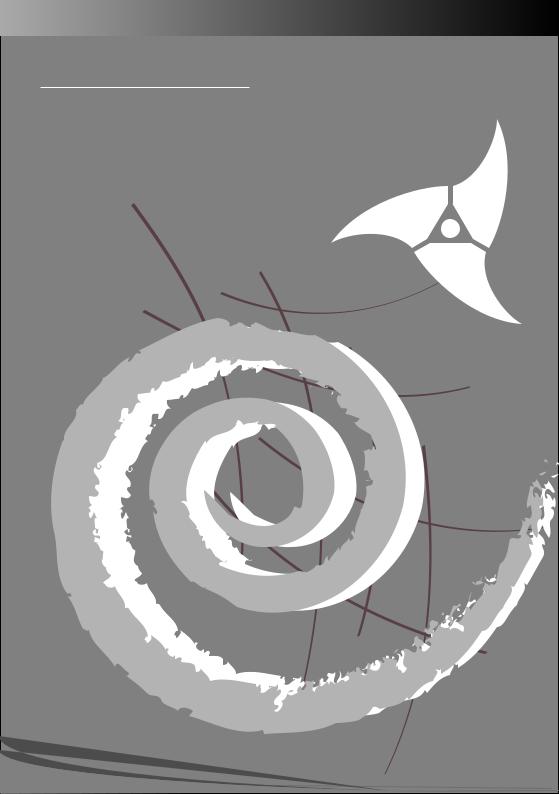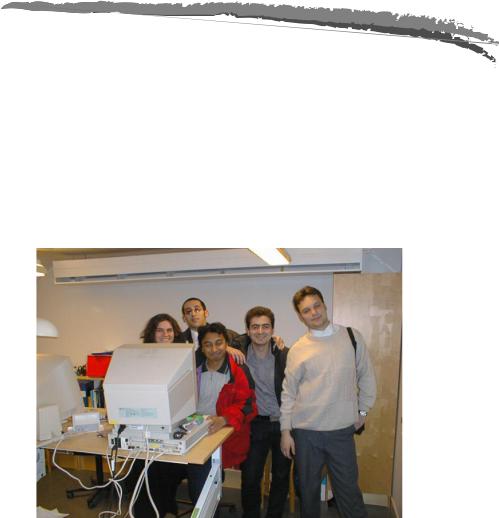
History Book of BEST
.pdf
31
Documentation
Last but not least, one essential part of BEST is the on-line archive that its members maintain. Initially the information circulated with diskettes, later hosted in an FTP server and now a vast network of documents available at all members at any time in every corner of Europe. The archive is the heart of the information of BEST.A sum of 12000 documents consisting of proposals, ideas, minutes of meetings and outcomes of discussion groups all together compile the identity of the organisation.
Besides the archive, a new technology for documentation appeared in BEST during the last year: the BESTipedia. A wiki-wiki system for storing information and developing documents grew slowly in the beginning, but after 3 years of usage it became a source of information with its 6500 pages available for all users.
‘‘(It has to be noted, that all the statistics and numbers were taken from the database on the 14th of March. Since not all the information about BEST is stored in the server most of the statistics are just indicators of the general picture of growth of BEST, and cannot be taken as absolutes.)’’

History Book of Board of European Students of Technology |
1989-2009 |
Chapter 2
BEST for Students
•Complementary Education
•Engineering Competitions
•Career Support
•Educational Involvement of BEST in European Higher Educational System

BEST for Students
SEASON COURSES
Starting points
Even from 1989, the moment that BEST was born, its main goal was established: to help the students of Europe. One of the main programmes discussed back then was a project that aimed in making learning programs of European Universities of Technology known among students. In this way, BEST would come to ease the students’ task to go and study abroad. Even if all LBG worked hard to reach this goal, the project was very hard to implement and soon BEST members thought of another solution.
So, the idea of courses organized by BEST in collaboration with the universities popped up during the General Assembly (GA) in Trondheim in 1990. At that time, it was the most important thing to do and it seemed easier for everyone to organize such events. The delegates then decided to have a list of topics that every university could hold a course about. “These courses should be about two or three weeks long and have to be taught in
English so that everyone can attend them. Obviously, they have to be scientific courses.
They should be prepared for groups of about twenty or thirty people. The range of time for holding these courses would be from June to October, both included. So this was the beginning of the Summer Season.
BEST programme of complementary education is one of the oldest and most important projects of BEST, aiming to broaden knowledge of European students, mainly in the field of technology, but also in other areas that can contribute to the personal development of every individual student involved. Courses organized within the programme all over Europe enhance participants knowledge in a way that complements the education provided by the participants own universities.
Therefore, the mission of Complementary Education Programme of BEST is “to facilitate selfdevelopment in the fields of engineering, management and cultural matters”.
The academic part of single BEST course is of course very important. It consists of lectures, case studies, company visits, research institutes visits etc. There are three major groups of learning events organized by the Local BEST Groups:
•Technologicalcourseisaneventaimedforincreasingandwideningtheprofessional knowledge in a certain field of technology, especially concerning modern technical applications of technology and the latest research achievements.
•Career related course is an event about non-technological subjects in order to develop personal skills in topics linked with working methods, communication techniques, marketing, economics, project and organization management and other such soft skills, stressing practical work.
But there is much more than the academic part of the course that can make the days with

Chapter 2:
BEST for Students
the fellow students from all over the Europe an unforgettable experience. It is a great opportunity to find out that students from all around Europe are alike, that there are no borders between them but still the different cultural backgrounds of participants make the event even more colourful and interesting. Besides getting to know the hosts’ city, country and culture better, looking beyond the walls of usual tourist attractions, you find out so many things about other countries and cultures through the eyes of other participants.
The next step was to have some regulations and recommendations about what was called “Summer Programme”. What was a “Summer Programme”? The actual season, with all the deadlines before included (the activity announcement, application, validation, ranking and optimization).
SUMMER PROGRAMME 1991
After a very long discussion and several subgroups working night and day at GA Trondheim on it the first rules and recommendations for the Summer Programme’91 were settled: Rules
•BEST reserves the right to stipulate the following minimums regarding the summer courses:
•All courses will admit at least 20 BEST students
•There must be some kind of evaluation of the course accompanied with valid proof of attendance.
•The BEST Summer Course at any organizing university may be a part of an already existing program as long as all the BEST minimum requisites are fulfilled.
•The level and topic of the course will be decided by the organizing university to the best extend of its abilities, keeping in mind that there will be 2 or 3 week courses with approximately 4 working hours a day.
•Each organizing university shall reserve 75% of the available BEST student places for other organizing universities students, rest of the places being awarded to students from non-organizing BEST universities. The host university reserves the right to enlarge the course for its own students and possible guests from sister schools.
•All the information and pre-requisites regarding the details of the course shall be submitted by each organizing university to all BEST related universities and the Secretariat by December 15th.
•The applications and pre-selection will be completed by the local BEST groups of the sending universities before the spring G.A. The exchange and assignment of places will take place at the G.A. Each local group will bring all its application organized in correlating order beginning with the best candidate.
•Each organizing university may send through the BEST network the equivalent to 75% of the available places of their own course.
•Within the 75% of the available places in any given summer course, there should be at least one place reserved for every organizing university. All remaining

places will be distributed between organizing university students at the G.A. by exchange.
•25% of the places will be distributed at the G.A. among students from nonorganizing universities.
•The organising university reserves the right to demand any type of written document to facilitate the acceptance of students to its course.
•Tuition costs will be covered by the organizing university. Room and board shall be provided in the most inexpensive way but preferably free.
All of these rules were to be respected by each university and LBG. Because back than we didn’t benefit of internet facilities and online application, the students were filling their application forms by pen and afterward gave them to the LBG from their university. The delegates at the GA from that specific LBG would take the applications and give them to the organizing LBG where the students applied. Another solution was to send the application along with their CV by snail mail until a specified date considered an application dead line
(DL).
This process was hard; the selection was made manually by BEST members, so there was no common procedure of selecting and ranking the applicants. At some point, some application were having added even pictures, but this got out of hand when in some LBGs the selection was made based on good looks and further on adding pictures was not allowed.
In 1992, during the GA in Helsinki and Tallinn, the first optimization was done. LBG Grenoble took the challenge to make the first manual optimisation. Its purpose was to fill most of the available places and allow students to apply for several Summer Courses (SC).The process was hard and it had several back-points. Year by year the system was improving, but it took lots of effort by BEST members and time.
“So, at the beginning of SP94 programme, we encountered different problems:
•The SP-posters and the SP-leaflet were made and distributed very late due to continuity problems and overloading of the responsible.
•The deadlines were postponed by the Vth Board because of the delay of the infomaterial and organizational problems.
•The new deadlines were subsequently passed by a large part of the SC organizers.
•There were major problems with the optimization which resulted in a further delay.
The result was that the first list of participants was distributed at the end of May. Some SCs started in the beginning of July, so the applicants had more or less given up hope and in some cases arranged other activities. This postponed the time even more before some of the participants were informed of their acceptance. The final result was a large number of unused places and a much larger number of not satisfied applicants.

Chapter 2:
BEST for Students
Some of the SCs had problems living up to the standards of the BEST SCs. Every SC is representing BEST toward its participants, so if a SC is poorly organized the whole BEST network is discredited” (notes from the VI-th board report).
The organizers always tried to get money from programs as ERASMUS or TEMPUS. For some of the seasons, we were financially sustained by the European Union, as we were applying for grants for the courses. A proposal for collaboration with FEANI was presented by the Board as they seemed to be interested to help locally for the Summer Courses, providing lecturers in technical subjects as they are Engineers first of all.
In GA 1994 in Turin, the first official “Book of making summer courses (SC)” was presented.
It was called SP (Summer Programme Book) and it included all the deadlines and advice for the SC organizers.
The SP-book
The SP-book was made to improve the “quality” of the SCs and to have a better knowledge management. It was made to improve the SP-booklet made by Ovidiu Sandor from the V-th board to decrease the papers needed for a SC organiser and to structure the Rules of the
BEST SP. The handbook was included in the book, some chapters from it were restructured and some minor changes were made.
To start from the structure of the book and then later deal with the contents it was treated as a completely new project, where the booklet and the rules were given as background material.
This book was to be updated after each season after gaining more and more experience.
In this period, lots of events (WorkShops) were needed to establish a common ground for the SP, some requirements and advices that each LBG was advised to follow. For this, the WorkShops in Kosice, Lund, and Barcelona gathered SPOC members that worked in making these BEST events easier to organize and better planned. During these events, they prepared all the information for the book and started organizing it and improving as much as they could.
As the SP was growing more and more, inside BEST a new team was born that was concerned about the complementary education offered by BEST: Season Program Optimisation Committee (SPOC or Vivaldi committee). SPOC was originally founded back in GA96 to solve problems related to optimisation of BEST summer programme. Originally known as Summer
Program Optimizing Committee, one of the committee early projects was to try to find a way of ranking the LBGs based on the quantity and quality of their activities (a project which was later dismissed).
Gradually, as the committee developed expertise on this and linked areas, SPOC evolved to implement and take care of the Vivaldi procedures and the quality of BEST complementary education. Also SPOC was involved in the development of the current optimisation engine, ”Johnny” (as a proper IT-committee didn’t exist by then).

Until ‘96 -’97 the application was still made by fax, or snail mail and the optimization was made manually. As internet appeared in the life of BEST members, SPOC considered that there was a constant need in having a system that would make the optimization automated. So some people from SPOC joined forces and started working at an optimization procedure
.Some people from the CMT was to design the content of the application and other members would implement it accordingly. From the ones that initially worked in the development of this application we can mention 2 guys from Timisoara: Ovidiu Sandor and Cristi Bogdan
.Ovidiu had a scholarship in Stockholm so the hosting for the server was there for a long time. The application was called “Johnny” (as the anonymous guy name in Romania) and the hosting was nada.kth.se.
SPOC delegates testing Johnny at GA 1998, Romania
Many of the members of both ITC and SPOC focused on Johnny server to make the optimization process better, so several versions of Johnny were launched during the years 96-98. After a couple of year Johnny turned into BEST Application System (BAS). It is practically the same application always updated with new features that make the life of BESTies easier.
In parallel, another project was developing inside SPOC. It was named GreenApple and it was a set of guidelines that would assure a nice standard for the organizing of courses.
The first attempt to discuss and develop a quality system for BEST Summer Courses was at IBS Athens (November 1998). The discussion group handled two case studies: “Building

Chapter 2:
BEST for Students
up a quality system for evaluating the experiences of foreign students at a university and how to improve the services if needed” and “A quality assurance system for BEST Summer
Courses” based on the outcomes of the first one.
The work on this topic continued during the working group about Quality Control at the PM98 in Torino (November 1998).
At IBS Gent (February 1999) a quality system was designed. The different steps of the system became more detailed. During the WS in Maribor (March 1999) the GeenApple system was finalised.
At the 17th GA in Lisbon (April 1999) the whole system was evaluated and we talked for the first time about the possible implementation during some demo courses in the Summer
Season 1999. The main problem that rose was the use of the word “Quality”.
During the Summer Season 1999, the quality system for BEST courses were implemented at 8 GreenApple demo courses. These courses took place in Valladolid, Athens, Lisbon, Budapest, Gothenburg, Ljubljana, Gent and Stockholm.
At the WS in Zagreb (October 1999), the demo courses were evaluated and the GreenApple procedure was modified (proposal #17-W-ZA-EDU-500).
During the PM in Chania (November 1999) the procedure was further discussed and the project presented to the delegates (proposal #17-P-CH-EDU-501).
With the GreenApple project, BEST tried to satisfy the European students of technology, to provide them with sufficient information about the course and make the course comply more with their expectations. The BEST members wanted to improve the quality of the complementary Education provided by BEST. With highly developed evaluation system the course organizers get feedback from the participants already when preparing the course, during the course and at the very end, which enables them to improve their way of working.
Until the end of the 2004 seasons, all of the LBGs applied the Green Apple standard in order for the LBGs to provide quality services for the European students of technology. After PM04 Portugal, GreenApple was no longer needed as there were no more any differences between a Vivaldi Event and a GreenApple one.
In 2003-2004 we developed a strong system that was offering students a good complementary educational program. It was clear for each LBG what they needed to do to have a good event so all the partied would benefit of. All of this information was provided by the Vivaldi
Procedure:
“There is a common procedure for promotion, application and evaluation of complementary

education activities within BEST, called Vivaldi procedure. This procedure is based on dividing the year into 3 seasons (spring, summer and winter) and having common promotion, application method and deadlines for all the events within a given season.
Important part of the procedure is “Johnny”, our special application/optimization/evaluation engine and related database (developed solely for BEST by Information Technology Committee). Being accessible through Internet, it offers a possibility for all the students from universities with Local BEST Group to apply to the announced activities (one person can apply for up to three events in one season). After the application period is over, the organizers choose the participants for their course, taking into consideration the motivation letters written by the applicants.
After the lists of selected participants are entered to Johnny by the course organizers the optimization is run, making sure that the students are accepted to a course high on their priority lists, but only to one learning course within the season (in addition they can be accepted for up to three leisure events).
Very important step at the end of the procedure is evaluation that has to be entered to Johnny by all the participants, giving feedback to the course organizers, so they can make improvement plans for the next event they will organize.
Even while Johnny offers great support for the event organizers, participants and SPOC, in the near future the “Johnny version 2” will be develop in co-operation by SPOC and ITCommittee to provide even better facilities for all the parties involved. (written by SPOC)
Recognition of BEST Events
Term “academic recognition” refers to the studies carried out at a foreign University, receiving credits for it (from that university) and later having these credits/courses recognized at the home university as part of the studies needed to accomplish a degree.
The project was launched in 2000 and it’s been ongoing until now (2009). The main goal of this project is that the home university recognizes BEST courses as academic courses and gives the students that attended the courses ECTS credits. For this to be easier , each LBG had to fill in for each participant an Course Information Form, an detailed document stating the academic part of he course as the cultural one too: the number of study hour, the topics studied, the structure and grade give at the exam, cultural achievements.
Merging SPOC and CWG
At PM 2004 it was first discussed a merger between SPOC and Competitions WG (CWG).
During ICF Bucharest in 2005 the plan was settled: the structure of the new CMT, knowledge transfer, tasks for the team, further steps, transition period, new framework and places for the international events and new webpage. After the ICF a new era started and a new CMT was born: External Events Committee. This CMT deals with both SPOC projects and

Chapter 2:
BEST for Students
Competition and succeeded to implement a good unified system for all types of events BEST was providing.
The year 2006 brought new changes for the complementary education. As BESTies considered that they can offer more to students, one of the approved proposals was to have 4 Seasons, not 3; therefore the Autumn Season was created and LBGs could organize in fall one week courses like the ones prepared for Winter and Spring Seasons.
“Another of the outcomes of the attempt to improve the complementary education service was the idea to investigate the possibility of having monthly-deadlines instead of seasondeadlines for preparing and announcing non-optimised events”. (GA 2006 report)
At the EEC Summer Meeting and BEST Academic System (BAS) Short Intensive Meeting (SIM) in the summer of 2006, investigation on the “Monthly Deadlines” concept has been made. As a conclusion a more advanced concept - Flexibility of organising non-optimised events - was brought to life, which would give full flexibility to announce the non-optimised event to the organising LBG. Promotion would be made by virtual tools, such as the Public Website or a Newsletter. This would have meant that Non-optimised events can be announced after the official announcement deadline of the season. These events would then have had a separate set of deadlines (application deadline, account validation deadline, final list deadline and confirmation deadline). The evaluation and deposit return deadlines, however, would have remained the same as those of the season in which the event took place. A second option was also introduced, that differs in the following: The application deadline would be fixed. The first option was preferred by the LBGs, but the proposal was not approved in the plenary. This was the first step in making non-academic courses more flexible.
In 2007 the EEC members stressed on the quality of the academic part of each course organized and it was concluded that a minimum standard must be set and followed by the LBGs. The quantity of events organized was a hot topic at GA France 2007. To motivate LBGs to organise more events, preferably public events, the idea to start a challenge club was presented. This club would gather all the challenges of the LBGs and be able to see the progress made later. Changes in the Vivaldi Handbook were made regarding the boundaries of a season, announcement procedures for an event and season deadlines procedure.
At PM 2007 Valladolid, the delegates approved to change the minimum number of participants at a BEST public event from 20 to 22. BESTies understood that at that moment BEST was not reaching all the students of technology across Europe that applied to the events therefore leaving many of them disappointed. Granting 2 more places in all events was still a small step but a strategic move for the future. At the same event, the term BEST public event was defines as BEST Course, Event on Education or BEST Engineering Competition leaving the leisure events aside as they didn’t provide the sae value for the students as the academic ones.
In 2008 both in GA Tallinn and PM Bucharest the idea of quantity was presented by many
